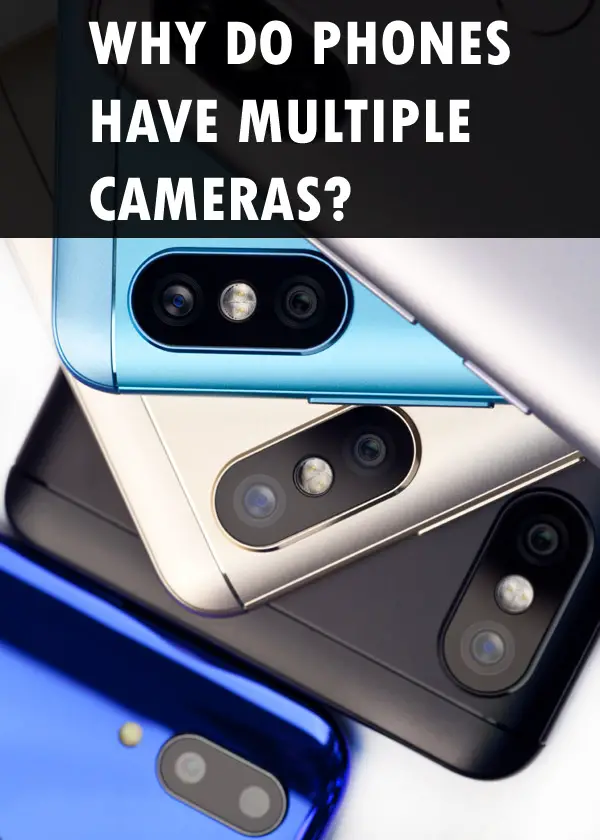Why do Phones Have Multiple Cameras? Which are Good?
Smartphones with multiple cameras have become a must-have for both photography enthusiasts and everyday users alike in recent years. These devices offer a range of features that cater to various photographic needs, from capturing stunning landscapes to snapping crisp portraits.

As you continue into this blog post, you’ll discover the key differences between single-camera and multi-camera smartphones, as well as the benefits and drawbacks associated with each type.
Let’s start by describing the types of lenses found in smartphones, as this will help you understand where multi camera phones originated.
Types of Lenses in Multi-Camera Smartphones
Modern smartphones feature a variety of lens types, such as wide-angle, telephoto, ultra-wide angle, or even macro and monochrome sensors. Each lens type serves a unique purpose, like capturing larger scenes with an extensive depth of field or increasing the contrast of full-color images without needing an ISP (Image Signal Processor). In this section, we will explore some common lens types found in today’s multi-camera smartphones.
Wide-angle lenses for basic photography needs
A wide-angle lens is designed to capture more content within the frame than standard lenses. This makes it ideal for landscape photography, group shots, and other scenarios where you want to fit more into your image. Many smartphone cameras come equipped with wide-angle lenses as their main camera lens because they offer versatility across various shooting situations.
Telephoto lenses providing shallow depth-of-field effects
Telephoto lenses, on the other hand, are used primarily for zooming into distant subjects while maintaining image quality. These specialized phones often have multiple camera modules that include telephoto lenses capable of offering optical zoom functionality instead of relying solely on digital zoom techniques. Optical zoom provides better overall image clarity by utilizing physical components rather than software-based processing methods.
Ultra-wide angle lenses capturing expansive scenes
An ultra-wide angle lens is designed to capture even more content within the frame than a standard wide-angle lens. This type of lens offers photographers the opportunity to take impressive panoramic shots and capture expansive vistas without needing to use panorama mode or combine multiple pictures. Flagship phones, such as the Samsung Galaxy S10 and Huawei P20 Pro, are increasingly utilizing ultra-wide angle lenses to capture more content within a single frame.
Macro and monochrome sensors for specialized photography
In addition to these primary lenses, some smartphones also feature macro and monochrome camera modules for specific purposes. Macro lenses allow phone owners to capture close-up details with impressive clarity, while monochrome sensors help enhance contrast levels in full-color images by capturing black-and-white data separately from color information.
Multi-camera smartphones offer an array of lens types that cater to various photography needs. From wide-angle lenses suitable for everyday use, telephoto options providing optical zoom capabilities, ultra-wide angle alternatives capturing expansive scenes, macro choices focusing on intricate details up-close – there’s something available for every smartphone photographer out there.

All these different types of lenses work together in today’s multi-camera smartphones, providing users with versatile photography capabilities that cater to various needs and preferences.
Multi-camera phones offer a vast selection of lenses, allowing photographers to capture images with heightened clarity and precision, thereby improving their photography prowess. Leveraging the power of time-of-flight sensors, smartphone cameras can now offer improved low light focusing capabilities and more accurate portrait mode photos.
Time-of-flight Sensors in Smartphone Cameras
Modern smartphones have come a long way in terms of camera technology, and one such advancement is the introduction of time-of-flight (ToF) sensors. These sensors are employed by devices like iPhones to measure depth, resulting in improved low-light focus and greater accuracy for features like Portrait mode. This advanced technology brings remarkable enhancements to both the picture quality and augmented reality features of today’s smartphones.
Improved Low-Light Focusing Using ToF Sensors

In low light conditions, traditional smartphone cameras often struggle with focusing due to insufficient contrast between objects. However, ToF sensors use infrared light to accurately measure distances between objects within a scene. This enables the camera system to achieve faster autofocus even when lighting conditions are less than ideal. Devices like Apple’s iPhone 12 Pro Max incorporate this advanced sensor technology into their rear cameras, providing users with an exceptional photography experience regardless of ambient lighting conditions.
Enhanced Accuracy in Portrait Mode
- Dual Camera Systems: Many modern smartphones utilize dual-camera systems that work together to create stunning portrait photos with professional-looking bokeh effects – where the subject remains sharp while the background appears blurred out smoothly. By combining data from multiple lenses or using specialized software algorithms, these devices can effectively simulate shallow depth-of-field effects typically achieved through DSLR cameras.
- ToF Sensor Integration: With the addition of ToF sensors into smartphone camera modules, devices can now capture accurate depth information which further refines portrait mode results by producing better edge detection around subjects as well as smoother transitions between the in-focus and out-of-focus areas of an image. For example, Samsung’s Galaxy S21 Ultra uses a ToF sensor to enhance its portrait mode capabilities, resulting in striking images that rival those taken by professional cameras.
Incorporating time-of-flight technology into smartphone camera systems has undoubtedly elevated their performance levels across various aspects such as low-light focusing and depth sensing for augmented reality applications. As manufacturers continue to innovate and refine these technologies, we can expect even greater advancements in mobile photography moving forward.
Portrait Mode Functionality Across Devices
The majority of recent smartphone releases come equipped with portrait mode functionality, which allows users to achieve professional-looking bokeh effects and enhance their photo editing capabilities. Some devices analyze depth information through multi-camera setups designed specifically for niche applications.
Achieving Portrait Mode Bokeh Effects with Dual Camera Systems
Smartphones with two cameras have gained much popularity as of late due to their capacity for creating impressive bokeh effects in portrait mode. This is achieved by utilizing the data from both cameras – one capturing a sharp image of the subject while the other captures background details – allowing for an adjustable depth-of-field effect that mimics professional DSLR photography. Examples of such smartphones include Apple’s iPhone XS series and Samsung’s Galaxy S9+.

Enhanced Photo Editing Capabilities Using Depth Data
In addition to creating impressive bokeh effects, multiple camera modules also provide phone owners with enhanced photo editing capabilities. By analyzing depth data captured by these specialized lenses, users can easily adjust focus points, blur intensity levels, or even apply various filters selectively on different parts of an image using advanced software like Adobe Lightroom Mobile or Google Photos’ built-in editor.
- Adobe Lightroom Mobile: A powerful mobile app offering extensive photo editing tools along with cloud storage integration for seamless workflow across devices.
- Google Photos: An all-in-one solution providing unlimited high-quality storage, smart organization features, and a built-in editor for quick adjustments on-the-go.
With the continuous advancements in smartphone camera technology, today’s smartphones are becoming more versatile tools for both amateur and professional photographers alike. The inclusion of multiple cameras not only improves image quality but also provides users with an array of creative options to explore their photography skills further. Specialized phones like the Huawei P20 Pro, for example, come equipped with a monochrome camera and telephoto lenses that offer optical zoom, while the LG V40 ThinQ features a wide-angle lens for capturing more expansive shots. As augmented reality continues to gain popularity, standalone cameras are also being developed to cater to this niche market.
Portrait mode functionality across devices has been a great way to enhance the photography experience, allowing photographers to create stunning bokeh effects with dual camera systems and take advantage of depth data for more advanced editing capabilities. Let’s now explore the various multiple-camera smartphones that are currently available on the market.
Current Multiple Camera Smartphones
In this fiercely competitive landscape of smartphones, makers are always attempting to give consumers the latest in camera technology. Both Android and iPhone devices offer impressive multi-camera smartphones that cater to various photography needs. Let’s take a look at some of the best multiple camera smartphones available.
Huawei P20 Pro featuring three rear cameras
The Huawei P20 Pro (buy here) stands out as one of the top contenders in this category, boasting an innovative triple-lens system on its rear side. The 40MP RGB, 20MP monochrome and 8MP telephoto lenses combine to offer users an impressive 5x optical zoom with excellent image quality. This powerful combination allows phone owners to capture stunning photos with optical zoom capabilities up to 5x without compromising on clarity or detail.
Samsung Galaxy S21 Ultra: A powerhouse in mobile photography
- Main Camera: 108MP wide-angle lens
- Ultra-Wide Camera: 12MP ultra-wide lens
- Telephoto Cameras: Dual 10MP telephoto lenses with 3x and 10x optical zoom capabilities
The Samsung Galaxy S21 Ultra (buy here) is another flagship phone that offers an impressive array of camera modules. Its rear side features a powerful quad-camera setup, including a high-resolution main sensor, an ultra-wide-angle lens for capturing more expansive scenes, and two separate telephoto lenses providing versatile zoom options. The device also supports up to 100x digital zoom known as “Space Zoom” for extreme close-ups.
iPhone 13 Pro: Apple’s most advanced smartphone camera system yet
- Main Camera: 12MP wide-angle lens with improved low-light performance
- Ultra-Wide Camera: 12MP ultra-wide lens with autofocus and macro photography support
- Telephoto Camera: 12MP telephoto lens with 3x optical zoom capability
The latest addition to the iPhone lineup, the iPhone 13 Pro (buy here), raises the bar even higher in terms of mobile photography prowess. This model introduces several enhancements over its predecessor, such as better low-light performance on its main wide-angle camera and new macro photography capabilities using the ultra-wide sensor. Additionally, it boasts a redesigned telephoto module offering increased optical zoom range compared to previous models. The iPhone also boasts advanced features such as Night mode on all lenses, Deep Fusion technology for improved low-light performance, and Smart HDR which intelligently adjusts exposure settings based on the scene being captured.
Google Pixel 6 Pro with dual rear cameras
The Google Pixel 6 Pro, (buy here) known for its exceptional image processing capabilities thanks to Google’s computational photography algorithms, offers two rear cameras: a primary wide-angle module featuring an impressive resolution of up to 50 megapixels and an ultrawide secondary camera. With Google’s software enhancements like Super Res Zoom (digital zoom) or Night Sight mode (low light), this smartphone can deliver stunning images despite having fewer lenses compared to other flagship phones.
In today’s smartphone market, where multiple cameras are becoming increasingly popular among phone owners who seek better photographic experiences from their devices, the Huawei P20 Pro, Samsung Galaxy S21 Ultra, iPhone 13 Pro Max, and Google Pixel 6 Pro are some of the best options available.
As technology advances, it will be interesting to see how AI & AR advancements affect future multi-camera smartphone technology trends.
Future Trends in Multi-Camera Smartphone Technology
As the demand for high-quality smartphone photography continues to grow, companies are constantly pushing the boundaries of what is possible with multi-camera systems.
The Impact of AI & AR Advancements on Future Smartphone Technology
AI and AR have revolutionized the modern smartphone, with features such as digital zoom and portrait mode being enhanced by AI-driven algorithms to deliver immersive gaming experiences and novel ways for users to interact with their environment. These cutting-edge innovations enable devices like the iPhone XR or Galaxy S9+ to deliver immersive gaming experiences as well as new ways for phone owners to interact with their surroundings through apps like Snapchat or Pokemon Go.
- Digital Zoom: Advanced image processing algorithms powered by AI technology allow budget-friendly devices without dedicated telephoto lenses to achieve impressive digital zoom capabilities while maintaining decent image quality.
- Portrait Mode: AI-driven depth sensing technology enables smartphone cameras to accurately separate the subject from the background, creating professional-looking bokeh effects even on devices with a single camera module.
- Augmented Reality: AR applications rely heavily on accurate depth data and high-resolution images provided by multiple camera modules in order to create realistic virtual overlays onto real-world environments.
The potential of multi-camera phones is extremely encouraging as companies strive to create new methods for users to take exceptional pictures, videos and immersive encounters. As these technologies become more advanced and accessible, it’s likely that we’ll see an increasing number of specialized phones catering specifically towards photography enthusiasts or those looking for unique AR capabilities.
FAQ
Why Do Mobile Phones Have Multiple Cameras?
Mobile phones have multiple cameras to enhance the overall photography experience by providing better image quality, depth sensing, and various focal lengths. This allows users to capture images with improved detail, dynamic range, low-light performance, and creative effects like bokeh or wide-angle shots.
Why Do Some Phones Have 3 Cameras?
Some smartphones feature three cameras to offer a versatile shooting experience. Typically consisting of a primary lens for standard photos, an ultra-wide angle lens for capturing expansive scenes, and a telephoto lens for zooming in on distant subjects without losing image quality. These combinations cater to different photographic needs and preferences.
What Phones Have Multiple Cameras?
A variety of smartphones come equipped with multiple camera systems such as the iPhone 12 Pro Max (triple rear camera), Samsung Galaxy S21 Ultra (quad-camera setup), Huawei P20 Pro (three rear cameras) among others. The number of lenses may vary depending on the manufacturer’s design choices and target audience.
What Are the Benefits of Having Multiple Smartphone Cameras?
The benefits of having multiple smartphone cameras include:
- Better image quality through computational photography
- Versatile shooting options with varying focal lengths
- In-depth data collection enabling advanced editing capabilities
- Faster autofocus using time-of-flight sensors
Phone owners can now enjoy the benefits of standalone cameras with the convenience of modern smartphones. With the rise of augmented reality and specialized phones, multi-camera smartphones are becoming increasingly popular. The Samsung Galaxy S9, for example, features a monochrome camera module that enhances low-light performance, while the Huawei P20 Pro boasts a triple camera setup with a 40-megapixel main camera, a 20-megapixel monochrome camera, and an 8-megapixel telephoto lens with optical zoom.
Flagship phones are leading the way in multi-camera technology, but even mid-range and budget smartphones are starting to incorporate multiple camera modules. Whether you’re a professional photographer or a casual snap-happy user, the benefits of multi-camera smartphones are undeniable.
Conclusion
Although they can be costlier than single camera smartphones and may have a bulkier design and heavier weight, the benefits outweigh the drawbacks for those who prioritize photography in their mobile devices.
Click on the following link to learn how to take stunning long exposure photos with an iphone.



